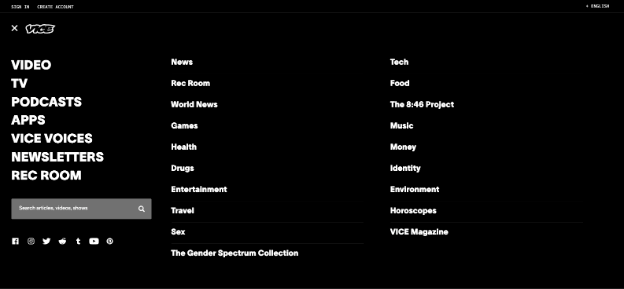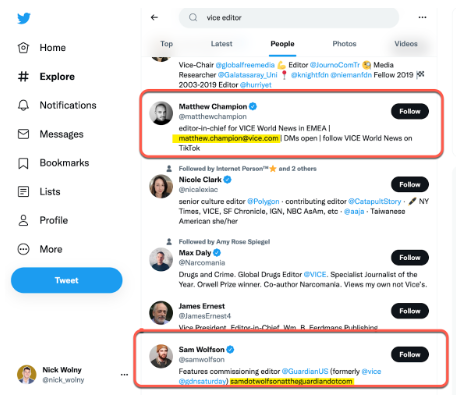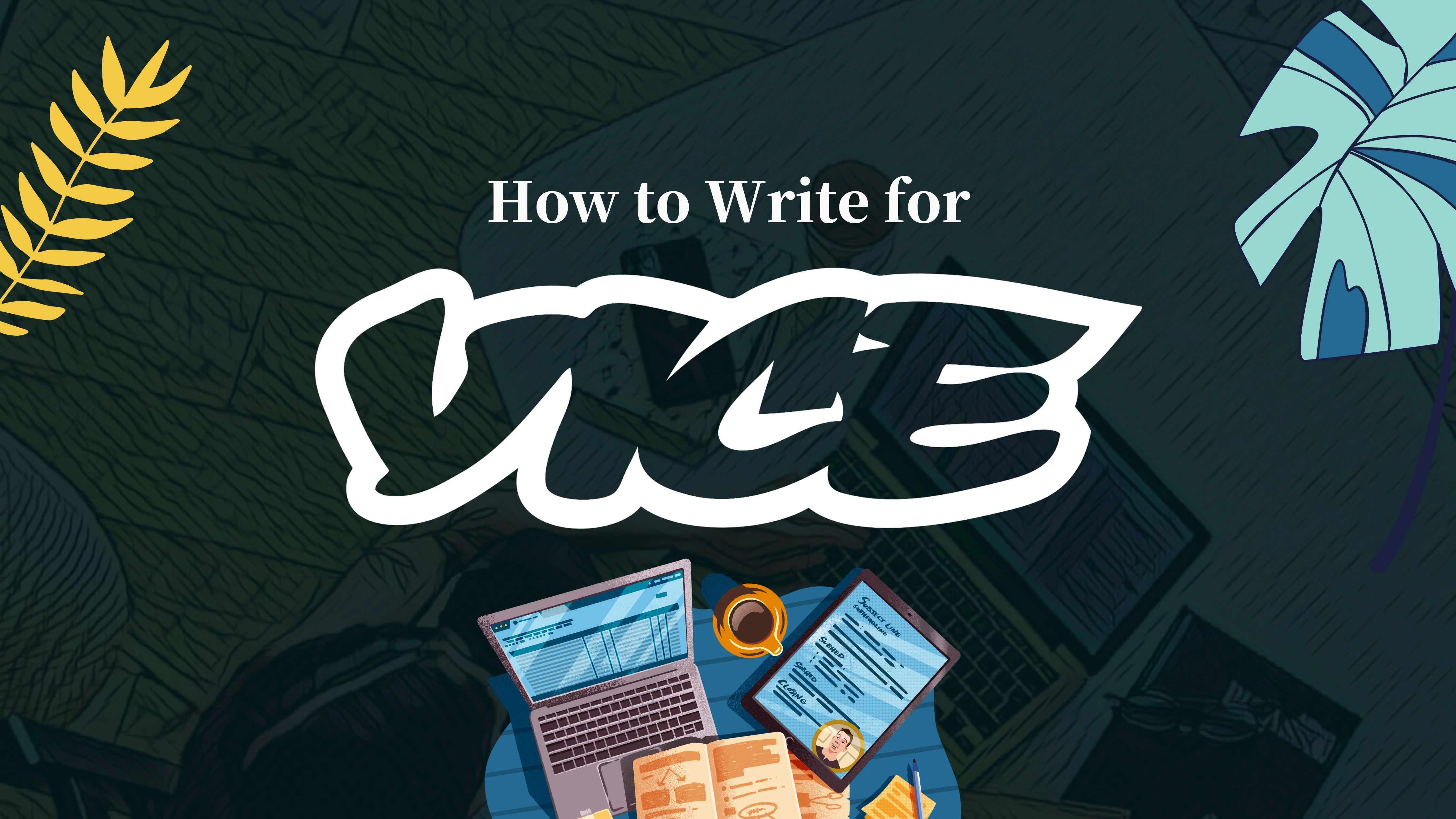What do personal finance misinformation, world politics commentary, and a video of a dude having s*x with a donkey have in common? They’re all stories that have been covered by VICE Media.
Established in 1994, the Canadian media outlet has had many evolutions, including a seven-year partnership with HBO that led to subchannels like VICELAND and VICE News Tonight.
Key Takeaways
- VICE is known for digging deep on typically taboo topics.
- The publication has won over the hearts of millions of viewers and readers over the years.
- VICE Media publishes approximately 2,400 pieces of content a week in 25 different languages.
More importantly, a byline in VICE gives you instant cool points. And here’s the good news: if you have a great story to tell or cover, and can land the point in a crisp, focused pitch, you don’t need a publicist or PR agency to write an article for them.
Here’s what to know about how to write for VICE, along with four steps you’ll want to take if you hope to land a byline with them someday.
What Topics Does VICE Cover?
VICE has covered a lot in its nearly thirty years of journalism, but a common throughline is that they go for stories or angles that aren’t being talked about anywhere else. The outlet began downsizing in 2019, so when it comes to writing for VICE, it’s good to check out the site and see which topics have their own verticals. This will give you some intel on which subjects are being covered consistently, which can help you ensure your pitch is a hit.
My advice is to first look at the site menu. From what I saw, VICE is focusing on several topics, from money to sex shopping to drugs to environmental issues, and more.

How to Write for VICE in 4 Steps:
- Read the outlet to see what they cover.
- Do some gatekeeper research.
- Send a well-formulated pitch via email.
- Write a clear, rigorous, stylistically correct essay.
Step No.1: Read VICE to Understand What They Cover
As with many other top-tier media outlets, one of the best ways to get a grip on what VICE covers is to sit down and actually start consuming what they publish. You can do a deep dive on the site whenever you like, but I find it more helpful to sign up for an outlet’s promotional channels so I can keep up throughout the week.
To keep up on what VICE is covering:
- Signing up for one or more of VICE’s newsletters.
- Following VICE on social media. Facebook Instagram Twitter YouTube Pinterest Reddit
- If there is a particular writer you enjoy, consider following them on social media as well.
People hate on VICE for the topics they cover, but I think their journalism is great. VICE World News is a valuable resource for international coverage, and their journalism on sex, drugs, and finance digs in on topics few other outlets would dare to cover.
As with most outlets, you’ll begin to notice trends over time with regard to what VICE covers. Use this awareness to help formulate your story ideas. What angles or topics that haven’t been written about yet would fit in perfectly with current coverage? Media is fickle, and the angles we cover change from time to time, so it’ll be helpful to look and see what is currently getting press as a starting point.
Step No. 2: Determine Who to Pitch at VICE
In order to end up writing for VICE, you need to pitch them via email. According to their website, the following email addresses are accepting pitches for consideration.
- Culture, music, entertainment, food: culture.pitches@vice.com
- Science, technology, gaming: tech.pitches@vice.com
- Lifestyle: lifestyle.pitches@vice.com
- Politics, inequality, health, environment, identity: issues.pitches@vice.com
- Drugs: Max Daly (max.daly@vice.com)
- Photo essays: Elizabeth Renstrom (elizabeth.renstrom@vice.com)
- Video: Eric Leven (eric.leven@vice.com)
These are the emails listed, but they’re not the only editors at VICE. It’s a good idea to do some research on social media to see who else assigns stories; in most cases, this person will have some sort of editor title.
PR professionals have databases of contacts, but you don’t necessarily need those to get ahead. My two favorite tools for researching potential contacts are LinkedIn and Twitter. On either platform, search a term like “VICE” or “VICE editor” and see what comes up. On Twitter, you’ll potentially find editors who list their job title in their bylines. You might also encounter other media contacts using this method.
In the screenshot below, I stumbled across an editor for The Guardian as well.

On LinkedIn, go to the publication’s business page, then click “see all employees on LinkedIn”. This will help you potentially identify editors by name. You can then do a search on these editors’ names to see their bylines and where else they are on social media.

Editors and journalists tend to promote their own work, and many list their email contact in their bio because they want to receive pitches and scoops, so by following them on social media, you can get more insight into what they’re covering.
Step No. 3: Send a Well-Formulated Pitch
By now, you know which section of VICE you want to pitch and who might be the right person to pitch with that information. It’s time to shoot your shot and email your article idea to an editor.
Pitching is an art form in itself, and there is no perfect pitch formula. I have personally seen success with both short and long pitches, and have accepted them myself. Think about your pitch as having three different components: relevancy, story, and urgency.
Relevancy
We first want to establish relevance in our pitch. We want to make it clear to the person reading our email that this pitch is specifically for them, for their outlet, and for a particular section of the outlet. Putting this information upfront will help an editor see that this is not a stock pitch, and that you’ve done your homework.
Story
Next, go into why the article needs to be written and published. Why would people want to read this article? Is there evidence that this topic is popular or timely? Sell the idea first and yourself second.
Urgency
Finally, communicate some details about what turnaround time would look like, and, if the article is topical or timely, why it should be published now and not later. These details cut down on administrative thinking and create more urgency.
With VICE — and most publications, unless otherwise specified — it’s better to get a green light on your idea first before submitting your article draft. An editor may want to sharpen or tweak your idea before approving it; having a clear scope first will save you time in the long run.
Step No. 4: Write a Clear and Rigorous Article
It’s time to write! Your editor may give guidelines on length when they assign a piece to you. Unless you’ve pitched a longer feature, articles will typically be between 600 and 1500 words; that’s between one-and-a-half and three typed single-spaced pages, for reference.
As you write your article, there are some strategies you can implement on the front-end that will cut down the editing process, ensure your article gets approved, and make a good first impression.
Clear
Editors want writers who can make a clear argument in plain English. A classic rule of thumb here is to communicate the who, what, where, when, why, and how of an issue.
If you’re writing an opinion piece, your article will be more about your perspective and providing context or experience as to how you’ve come to that conclusion. Opinion pieces are one-sided by design, and are powered by personal perspective and/or expertise.
If you’re writing a more journalistic article, the principles of journalism and media writing will apply. In journalistic writing, the writer or reporter is neutral and is not a character in the story; they are a messenger of important information, and a translator of sorts. It’s the writer’s job to make sense of complex or connected ideas using the written word.
Sometimes a writer sprinkles in some of their personal experience, or the experience they had while writing the story itself. This is known as gonzo journalism.
Rigorous
Back up what you say with evidence or research. “People are tired of working from home”... okay… says who? What outside evidence supports this? Go the extra mile to back up any and all claims; this results in stronger, more potent writing when writing for media. It’s an editor’s job to poke holes in your argument in order to make it stronger, so by doing this work upfront, your content will be clearer and easier to follow.
Stylistically correct
You need to write with good grammar and syntax when pitching media articles. Generally, following the AP style guide will be your best plan of attack for VICE and most other bylines. If you see yourself writing online often, AP Stylebook has online tools that scan and check your work for less than $5 a month.
Additionally, here is a VICE Style Guide that leaked in 2014. The guide’s cheekiness gives you further insight into VICE’s voice. Note that the voice is punchy, but not crass. It may not be the most updated version, but it will give you a general idea of what kind of precision VICE is looking for.
In review:
- Start reading VICE regularly to get a feel for their style and tone.
- Do research on who works at VICE and how the outlet accepts pitches.
- Send in a pitch that has relevancy, story, and urgency, in that order.
- Write a quality article that is clear, rigorous, and stylistically correct.
FAQs About Writing for VICE
How much does VICE pay for an article?
It’s hard to say, as the length and scope of an article will greatly vary. Most digital media outlets pay between $250 and $750 for a standalone piece, with higher payment for longer features. Whenever possible, get clarity from your editor on how and when you will be paid prior to the start of the process.
Does anyone actually read the emails sent to those general email addresses?
Here’s my take: if the outlet didn’t want you to pitch them, they wouldn’t put “how to pitch us” contact information on their website. Media outlets need pitches and like to retain and feature writers from a variety of backgrounds with a variety of different perspectives.
Try to pitch an actual editor if you can, and only one editor at a time.
How often should I follow up on my pitch?
A good rule of thumb is two follow-ups total, and to follow up if you haven’t heard back in a week or so. If the pitch is for a breaking topic, a next-day or same-day follow-up might be appropriate, but this is only if you’re trying to publish hard news or a very timely topic.
What should I do if I don’t hear back about my pitch, or if my pitch gets rejected?
Keep trying! Often, because of volume, we editors can’t respond to pitches that we’re not pursuing. Otherwise, we’d just be replying to emails all day long. Consider tweaking your pitch, or recycle it and try sending it to an editor at a different outlet. Adjust your pitch accordingly so that it’s a fit for the next outlet you pitch.
Who is the editor in chief at VICE?
VICE is a conglomerate of different brands, so there is no one editor in chief. But you shouldn’t be pitching the editor in chief at large media outlets anyway. At this level, editors-in-chief are managing their other editors and team members, not culling through pitches. Target an editor, managing editor, senior editor, contributing editor, or assistant editor instead if you can.
How to Write For VICE: Final Takeaways
Writing for VICE can feel intimidating at first, but when you take the steps listed above, you’ll maximize your chances for success and improve along the way. And by following the brand, you’ll see what does get published and sharpen your overall palate for writing. When you’ve landed a byline once, you’re able to leverage it as a credibility marker for the rest of your career.
Thanks For Reading 🙏🏼
Keep up the momentum with one or more of these next steps:
📣 Share this post with your network or a friend. Sharing helps spread the word, and posts are formatted to be both easy to read and easy to curate – you'll look savvy and informed.
📲 Hang out with me on another platform. I'm active on Medium, Instagram, and LinkedIn – if you're on any of those, say hello.
📬 Sign up for my free email list. This is where my best, most exclusive and most valuable content gets published. Use any of the signup boxes on the site.
🏕 Up your writing game: Camp Wordsmith is a free online resources portal all about writing and media. Get instant access to resources and templates guaranteed to make your marketing hustle faster, better, easier, and more fun. Sign up for free here.
📊 Hire me for consulting. I provide 1-on-1 consultations through my company, Hefty Media Group. We're a certified diversity supplier with the National Gay & Lesbian Chamber of Commerce. Learn more here.


